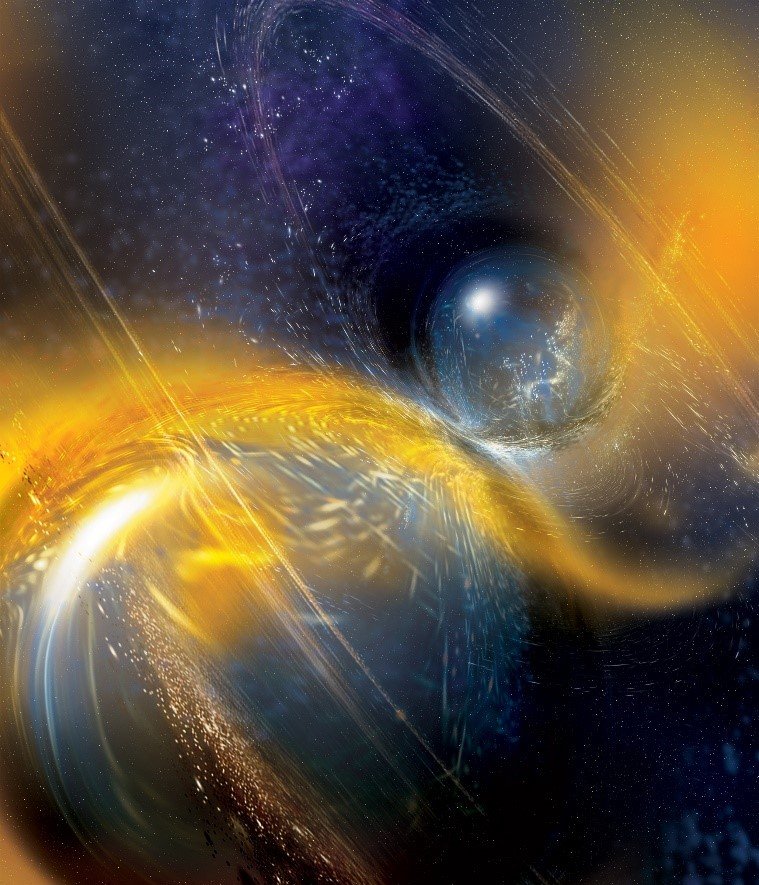Jan 7 2020
Scientists at The University of Western Australia have contributed to a new study with the ARC Centre of Excellence for Gravitational Wave Discovery (OzGrav) revealing a possible collision of two neutron stars 3.4 times heavier than the sun.
 Image credit: NSF/LIGO/Sonoma State University/A. Simonnet
Image credit: NSF/LIGO/Sonoma State University/A. Simonnet
The gravitational-wave observatory network, including the National Science Foundation's LIGO and the European Virgo detectors, picked up what appeared to be gravitational ripples from a collision of two neutron stars on 25 April 2019, the second time this type of cosmic event has ever been detected.
Neutron stars are the remnants of dead stars that exploded. When two neutron stars spiral together, they undergo a violent merger that sends gravitational waves shuddering through the fabric of space and time.
Gravitational waves and light were first witnessed in the same event in 2017 and was named GW170817.
UWA and ARC DECRA Post-Doctoral Fellow Dr Eric Howell said the detection is a significant achievement.
"Unlike the first detection of a binary neutron star, GW170817, no associated light was observed despite extensive follow-up efforts. This was not surprising as this event (i.e. 25 April 2019 called GW190425) was at much greater distance and not well localised in the sky, both factors making it highly challenging for space and ground based telescopes," Dr Howell said.
One of the roles of scientists at UWA was to ‘crunch the numbers’, or analyse the massive amount of data collected by the gravitational wave detectors.
UWA researchers Professor Linqing Wen and Research Fellow Qi Chu have been operating one of the five online pipelines to search for gravitational waves in real time, and generate open public alerts for prompt follow up observations from other telescopes. The pipeline developed at UWA, named SPIIR, independently identified this new binary neutron star event, and helped confirm the discovery. The SPIIR effort is supported in part by the Australian Research Council (ARC) through the establishment of the 2017 ARC Centre of Excellence for Gravitational Wave Discovery (OzGrav).
PhD student Mr Manoj Kovalam, who is heavily involved in the online real-time search for gravitational waves, said it was an exciting discovery.
“Since our software routine, SPIIR, is a low-latency pipeline, we get to identify Gravitational Wave events in real-time. We were very excited to see GW190425 because it is the second observation of a Binary Neutron Star merger.” he said.
“The interesting thing about this binary is that its total mass is significantly higher than any other known binary systems."
Neutron star pairs are thought to form either early in life—when companion massive stars successively die one by one—or when they come together later in life within dense, busy environments. The data from the 2019 event did not indicate which of these scenarios was more likely—more data and new models will be needed to explain the unexpectedly high mass.
UWA scientists were involved in the first detection of gravitational waves in 2015. Those waves were generated by the fierce collision of two black holes. Since then, scientists have registered dozens of new candidate black hole mergers. The first detection of a neutron star merger took place two years later, in 2017.
UWA's contributions to the international effort in gravitational wave detection and follow-up observations include instrumentation (led by Professors Li Ju and Chunnong Zhao), online real-time detection (led by Professor Linqing Wen and Research Fellow Dr Qi Chu), and optical follow-up observations with the Zadko telescope (led by Professor David Coward and Dr Bruce Gendre).